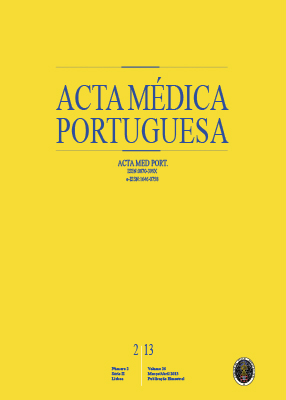Restraints to Anticoagulation Prescription in Atrial Fibrillation and Attitude Towards the New Oral Anticoagulants
DOI:
https://doi.org/10.20344/amp.4105Abstract
Introduction and Objectives: To evaluate the prescription rate of oral anticoagulants in atrial fibrillation, the factors associated with non-prescription, the reasons referred by the physicians for not prescribing anticoagulants including the new generation anticoagulants, and to perform a medium term follow-up assessment. Materials and Methods: Prospective study on consecutive patients with atrial fibrillation with hospital discharge. The CHA2DS2VASc and HASBLED scores, associated comorbidities and medication prescribed before and at discharge were assessed. At discharge, the reason for not prescribing oral anticoagulants and the new oral anticoagulants was indicated by the physician in a questionnaire. Exclusion: absolute contraindication for anticoagulation, CHA2DS2VASc ≤ 1 and valvular disease. Follow-up data were obtained one year after the recruitment of the first patient. Results: 103 candidates for oral anticoagulants were identified (79.6 ± 8.0 years; CHA2DS2VASc 5.8 ± 1.4; HASBLED 2.6 ± 1.0; HASBLED ≥ 3 in 55.3%); the anticoagulants were prescribed in 34.0% of the candidates. The factors associated with non-prescription were, in decreasing order of relevance: previous use of antiplatelet agents, bedridden and/or demented patient, absence of heart failure and number of bleeding risk factors. The reasons referred by physicians for non-prescription were, in decreasing order of frequency: high bleeding risk, small benefit, inability to comply with the treatment regimen and difficulty in monitoring the international normalized ratio (INR). The new anticoagulants were not prescribed and the referred reasons were, in decreasing order of frequency: insufficient information on the drugs, high bleeding risk, high cost and small benefit. At 8.2 ± 2.5 months of follow-up 33.3% of the patients were on anticoagulation and the new anticoagulants had not been prescribed. Conclusions: In this sample, the anticoagulants prescription rate was low and the factor most associated with non-prescription was the previous use of antiplatelet agents. Bleeding risk was the most referred barrier for prescription, followed by a small recognized benefit. The main referred barriers for new anticoagulants prescription were insufficient information and high bleeding risk. At medium-term follow-up the proportion of patients under anticoagulation was still low and the new anticoagulants had not been prescribed.
Downloads
Downloads
How to Cite
Issue
Section
License
All the articles published in the AMP are open access and comply with the requirements of funding agencies or academic institutions. The AMP is governed by the terms of the Creative Commons ‘Attribution – Non-Commercial Use - (CC-BY-NC)’ license, regarding the use by third parties.
It is the author’s responsibility to obtain approval for the reproduction of figures, tables, etc. from other publications.
Upon acceptance of an article for publication, the authors will be asked to complete the ICMJE “Copyright Liability and Copyright Sharing Statement “(http://www.actamedicaportuguesa.com/info/AMP-NormasPublicacao.pdf) and the “Declaration of Potential Conflicts of Interest” (http:// www.icmje.org/conflicts-of-interest). An e-mail will be sent to the corresponding author to acknowledge receipt of the manuscript.
After publication, the authors are authorised to make their articles available in repositories of their institutions of origin, as long as they always mention where they were published and according to the Creative Commons license.









